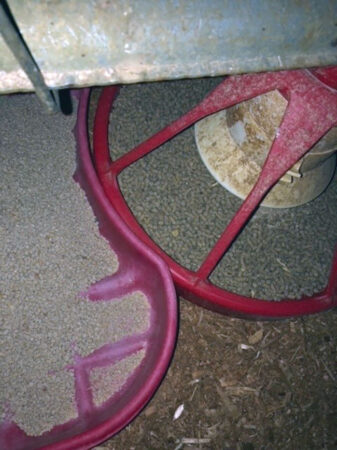
The Brooding Notebook: Cracking a starve-out puzzle
September 12, 2024
By Dr. Gigi Lin
An unexpected issue with the feed system led to a sudden spike in chick mortality, underscoring the importance of thorough feedline inspections and proper staff training in brooding management.
 Photo: Dr. Gigi Lin
Photo: Dr. Gigi Lin Case Summary: A five-day-old broiler flock experienced a sudden mortality spike with necropsies revealed starve-out condition. I visited the barn to help identify the underlying cause and found an unexpected issue with the feed system. Following some corrective actions, fortunately, the mortality rates returned to normal level. The farm team also implemented preventative measures to avoid future occurrences, highlighting a critical lesson in brooding management.
Case History and Postmortem Exam Findings: In the summer of 2022, I received a necropsy submission from a five-day-old conventional broiler flock due to a sudden increase in mortality. Among the 15 dead chicks submitted, most had lesions that were consistent with typical starve-out conditions. The chicks did not have any external lesions; their navels were healed, and their yolk sacs were well-absorbed. Their crops and gizzards contained only small amounts of feed materials and were mostly filled with varying amounts of litter. Only two out of the 15 chicks submitted showed signs of bacterial infection. The farm manager reported normal environmental conditions, with no recent drastic changes in management.
Field Evaluation: As with any early mortality and starve-out cases, I started the investigation by trying to identify the underlying cause, particularly to evaluate if the chicks were exposed to any external factors preventing regular feed intake. The next day, I visited the barn to perform a routine brooding investigation. Upon entering the barn, the flock was bright and alert, spread out evenly in the barn. I conducted a comprehensive brooding assessment, evaluating temperature, feed, litter, air quality, water, and sanitation (TFLAWS).

Finisher feed pellets in the feed pan (right). Normal chick crumbles on the supplementary pan (left).
After the initial evaluation, I did not identify any abnormal brooding conditions. The feed pans and feed lines were at good levels, with adequate feed volume in each pan. I spoke with the farm manager again to obtain more history. This is a well-managed farm, and the flock appeared normal for the first three days after placement. The mortality level increased by 0.4 per cent between four to five days of age. I also necropsied more dead chicks on-site and confirmed again that most of the mortalities were due to starve-outs.
Based on the history and necropsy findings, I was convinced that there were likely some underlying factors hindering feed intake. I decided to conduct another more thorough inspection, particularly focusing on the feed and feed system. I started by examining the feed from three pans of each feed line (the trigger pan, center, and end of the line).
I discovered that the first 10 to 15 pans of each feedline were filled with large pieces of feed pellets consistent with finisher feed instead of chick crumble. The rest of the feedline contained normal chick crumble. This was most likely caused by incomplete clean-out of finisher feed from the previous cycle, leaving finisher pellets in almost 15 per cent of the line. The young chicks, preferring a smaller feed size, refused to eat the larger pellets, leading to feed refusal and increased starvation in some of the chicks.
Management Plan and Clinical Outcome: The solution was straightforward once the primary problem was identified. The farm team cleaned out most of the finisher pellets from the system and ensured the rest of the lines were filled with chick crumbles. To improve feed access, the team also placed extra crumbles in supplementary feeding pans throughout the barn. This immediate intervention resolved the starve-out issue, and the mortality level quickly returned to normal the next day, with no subsequent problem reported.
Lesson Learned: The farm manager reported that a new summer worker who was not familiar with the barn system was hired to help with barn clean-out and set-up. To prevent future occurrences, the farm manager has added a section on feedline clean-out after depletion on their new employee training section. This was not only a great lesson for the farm team but also a reminder for me that many aspects of brooding management can go wrong and require close attention to details.
Minimizing starve-out conditions due to feed system errors
- Inspect the entire feed system regularly, including the feed bins, hopper, feed augers, and individual feed pans. Repair or replace broken pans immediately.
- Ensure thorough feed clean-out after each depletion. Remove leftover feed from the bins and the rest of the system to avoid accumulation of old feed that may become rancid or moldy. Ensure feed augers are functioning normally.
- Pay extra attention to the trigger pans. Ensure the trigger pans are well-lit to attract chicks to feed sources and help them locate feed right away upon placement.
- Inspect feed quality before chick arrival and ensure feed size is appropriate. Crumbles that are either too powdery or too large are not ideal and should be replaced.
- Have extra creep feed available in supplementary pans or chick papers on the first few days to improve feed access.
Dr. Gigi Lin is a board-certified poultry veterinarian. She provides diagnostic, research, consultation, continuing education, and field services to all levels of the poultry industry in Western Canada. In this column, she will share case-based reviews of brooding best practices.